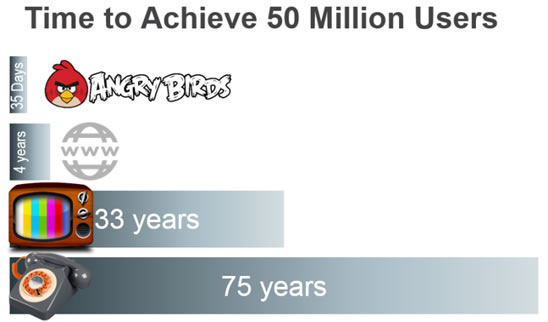
One of the most popular statistics cited for technology diffusion and the associated hyper-accelerated increase in technology adoption is the so-called “Angry Birds” Internet meme. The premise is this: it took the telephone 75 years to get to 50 million users, but it took the Angry Birds gaming application 35 days. A quick google fact check shows these stats to be a bit squishy, but the conclusion is the same. The technology is here, and the time is now. Angry Birds: Space was able to get to 50 million users in 35 days because the network was in place to support widespread adoption of the application.
This rate of uptake and its incremental revenue can only be achieved with a network and supporting software that is ready to exploit it, and users who are hungry for the service. Your customers have the appetite to consume services at Angry-Bird speed. Right now. Don’t you want a bigger piece of that pie?
These global networking trends are driving the network evolution:
- Mobility, including digital business, the enabled consumer, and the distributed workforce
- Social media (YouTube, LinkedIn, Facebook, Twitter, Instagram, Snapchat, WhatsApp)
- Cloud commerce (online shopping and auctions, the application economy, the sharing economy, and streaming entertainment)
- Big data and its monetization—social media monetizes the information and network-usage patterns, analytics, better interaction, more interaction
- Internet of Things (IOT)
The typical network and its supporting operations requires weeks or months to roll out new revenue-generating services, as opposed to cloud providers, who can turn up new services instantly. These cloud builders are dynamic and capable of delivering single-purpose services that fulfill a timely need or trend. Service providers need innovation, now more than ever, to get into that game. We must transition from our traditional static operating model to on-demand, automated, and programmable networks. And this transition demands a new way of thinking about carrier networks.
To get there, you need an open, adaptable, programmable network.
By “open,” we mean open-open. Publishing a Software Developer’s Kit (SDK) to a vendor-proprietary system and calling that “open” isn’t what we mean. When we say “open,” we are referring to interoperable systems that are built on open-source technologies. We mean vendors that will bring you more innovative technologies, with inherently complementary services and appliances. Open-source simplifies things—and avoids vendor lock-in.
An “adaptable network” has reduced operations and management complexity, improved service creation and activation times, and is nimble. Spend your precious resources developing a conscious network that is capable of self-optimizing. When you see this, make that change. Quickly. Without rolling a truck.
When we talk about network programmability, we are referring to more than simple provisioning. We are describing the kind of network intelligence that facilitates zero-touch provisioning, resilience, and fault management. This kind of network intelligence will allow us to create a service-driven network that we can do different, exciting things with—things unimaginable only a few short years ago.
The network you have today can do this, but it must evolve.
- Open up your network. Partner with multiple suppliers and build new NEs, defining the services you want to deliver along the way. No excess, no functionality that you don’t need. No wasted resources or capital expense.
- Start thinking about disaggregating the hardware: big iron routers, packet shelves, form factors, software, lambda, transport, switching, and access. Pull that hardware out of the static chassis. Going forward, only buy network elements that you use and pay for, and use software to manage and program it.
- Get comfortable with the idea of using centralized software that has a global view of the network; automatically allocate resources where they are needed and when they are needed, dynamically optimizing network performance in real time.
- Be creative about what kind of services and products a virtualized datacenter can deliver.
- Above all—put your customers first. Don’t start with the premise that you can only do what the network will allow you to do; think about the services consumers are clamoring for, then find a way to deliver that.
At Fujitsu, we think about Human-centric innovation all the time. We see that consumer expectations are changing and increasing, and we are responding with networks that are more aware, more adaptive, and more agile. We believe the network must transform to meet its customers’ needs. We are committed to quickly and effectively connecting people to the experiences they seek by facilitating access to content and information, not just the underlying technology.
It’s a very exciting time at Fujitsu. In the coming weeks, please visit us here to see how this vision is playing out… we’re also interested in your feedback. DM us on Twitter @FujitsuFNC, or email us on LinkedIn.
Author’s Note: Special thanks goes to fellow author and principal solutions architect Bill Beesley, who provided most of the technical perspective for this blog post in his presentation at our Fujitsu Solution Days demo events in November 2014 and 2015.
